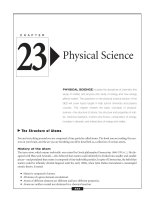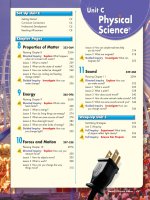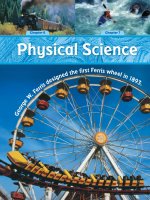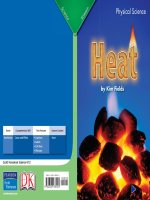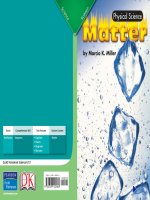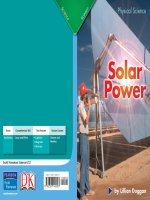3 11 everyday reactions (physical science)
Bạn đang xem bản rút gọn của tài liệu. Xem và tải ngay bản đầy đủ của tài liệu tại đây (2.96 MB, 10 trang )
Genre
Nonfiction
Comprehension Skill
Cause and Effect
Text Features
•
•
•
•
Captions
Diagrams
Labels
Glossary
Science Content
Changes in Matter
Scott Foresman Science 3.11
ISBN 0-328-13840-1
ì<(sk$m)=bdieab< +^-Ä-U-Ä-U
Vocabulary
Extended Vocabulary
chemical change
physical change
mixture
solution
states of matter
antacid
chemistry
combustion
digestion
electrochemical
reaction
enzymes
neutralization
Picture Credits
Every effort has been made to secure permission and provide appropriate credit for photographic material.
The publisher deeply regrets any omission and pledges to correct errors called to its attention in subsequent editions.
Photo locators denoted as follows: Top (T), Center (C), Bottom (B), Left (L), Right (R), Background (Bkgd).
Opener: The Nation/AP/Wide World Photos; 1 Digital Vision; 6 (BR) Corbis; 7 Bettmann/Corbis; 9 The Nation/AP/
Wide World Photos; 14 (TR) David R. Frazier/Photo Researchers, Inc.
Unless otherwise acknowledged, all photographs are the copyright © of Dorling Kindersley, a division of Pearson.
ISBN: 0-328-13840-1
Copyright © Pearson Education, Inc. All Rights Reserved. Printed in the United States of America.
This publication is protected by Copyright, and permission should be obtained from the publisher prior to any
prohibited reproduction, storage in a retrieval system, or transmission in any form by any means, electronic,
mechanical, photocopying, recording, or likewise. For information regarding permission(s), write to
Permissions Department, Scott Foresman, 1900 East Lake Avenue, Glenview, Illinois 60025.
3 4 5 6 7 8 9 10 V010 13 12 11 10 09 08 07 06 05
What did you learn?
1. When yeast and sugar react,
what new material is produced?
2. What are the three necessary
ingredients for combustion?
3. How does soap remove dirt from
a surface?
by Lisa Oram
4.
In this book
you have read about many reactions.
Write to explain the reaction that
takes place when a car’s air bag
opens. Use details from the book.
5.
Cause and Effect What is
the effect of an acid and a base
mixing together?
What You Already Know
Matter can change in many ways. A physical
change causes matter to change the way it looks.
But it does not change the kind of matter. A
banana undergoes a physical change when it
is sliced. A whole banana and a sliced banana
are both bananas. Slicing the fruit caused a
physical change.
One special physical change is a change in
the state of the matter. There are three states
of matter: liquid, solid, and gas. Liquid water
freezes into ice. It changes from a liquid to a
solid. Liquid water and ice are just different
forms of the same kind of matter.
A chemical change causes one kind of matter
to change into another kind of matter. When
wood is burned, it becomes ash and smoke. Ash
is not wood. Ash cannot become wood again.
Burning caused a chemical change.
2
When two or more kinds of matter are
combined, they can form a mixture. Mixtures are
not a new kind of matter. Their ingredients can
be separated. Salad is a mixture of several kinds
of vegetables.
A solution is a kind of mixture in which one
or more substances dissolve in another. Lemonade
powder mixed with water forms a solution. The
powder dissolves in water.
Many other changes in everyday life are
pretty amazing. How does soap get you
clean? How does food make you
strong? This book explores how
these everyday reactions work.
A salad is a mixture
of vegetables.
3
Reactions All Around
Have you ever used a cold pack on a sprained
ankle? One kind of cold pack must be kept in the
freezer to stay cold. Another kind of cold pack
just needs a squeeze to become cold.
When you squeeze this kind of pack, the
substances inside mix together. One of them is
water. The other is a chemical called ammonium
nitrate. A reaction takes place when they are
mixed together. This reaction takes in heat. Then
the pack feels cold.
Hot packs also take advantage of a reaction
involving heat. Instead of ammonium nitrate,
they are filled with either calcium
chloride or magnesium sulfate. Both
substances release heat when mixed
with water.
cold pack
4
cement
A chemical reaction
takes place when
cement is made.
What about preparing cement to build a brick
wall? Cement begins as a dry powder. Mixing
it with water forms a paste, which is spread
between the bricks. A reaction takes place. The
paste dries to form a strong, solid material.
These reactions show the difference between
a physical change and a chemical change.
Adding water to cold and hot packs changes the
temperature but not the materials involved. It
causes a physical change. Adding water to cement
changes the materials involved. It causes a new
kind of matter to form, which is a chemical
change. Chemical changes require chemical
reactions. Chemical reactions take place around
us every day.
5
A chemical
reaction inflates
a car’s air bag.
Filling Up
Chemical reactions even take place in the
kitchen. For example, the heat of an oven can
turn a mixture of ingredients into bread.
Bread starts out as a dough mixture that
includes yeast and sugar. When yeast and sugar
react, it produces carbon dioxide gas. Kneading,
or pressing, the dough makes it stringy and
stretchy. Then the dough can trap the gas bubbles
that are made by the yeast and sugar reaction.
The dough rests after kneading. During that
time, carbon dioxide bubbles fill the dough. Then
it becomes light and spongy. Baking is the final
step before you can eat the bread.
dough after
rising
Baking bread
involves
chemical
reactions.
kneaded
dough
dough
mixture
6
baked loaf
When a car’s air bag opens, it fills with gas
just like bread. Two chemicals are inside the
air bag system. They are called sodium azide
and potassium nitrate.
When a car stops suddenly, a sensor inside
the steering wheel generates an electrical current.
This causes a spark, which ignites the sodium
azide. The sodium azide reacts with the potassium
nitrate to form a gas called nitrogen. This is a very
powerful reaction. The nitrogen blasts into the
air bag at a speed approaching 250 miles per hour,
inflating the bag in an instant. Fortunately, the
nitrogen moves out of the air bag quickly, and the
car’s passengers are able to move.
7
Burning Bright
A candle burns brightly
when an upside-down
jar is first placed on
top of it.
The flame goes out
when the oxygen in
the jar is used up.
8
Most people enjoy
burning candles or sitting
near a roaring campfire.
But fire must be controlled.
It can be very dangerous.
What causes fire?
Fuel, oxygen, and heat
combine in a chemical
reaction called combustion.
Many different substances
can be fuel for a fire.
Wax, wood, and paper
are all examples. Oxygen
is a gas found in the air.
When oxygen and fuel
are mixed and heated to a
high temperature, they will
combust. Combustion is
burning. When something
burns, it is very hot.
Smothering a fire with
foam will block oxygen
from reaching it.
Once a fire has started, it can grow quickly.
As long as there is fuel and oxygen around,
the fire will continue burning. To stop a fire,
the fuel, heat, or oxygen must be taken away.
If trees are cleared from around a forest fire,
the fire will not have enough fuel. Spraying cool
water onto the fuel source will lower the heat of
a fire. And smothering a fire with water or foam
will block oxygen. Firefighters use foam to cover
materials that are no longer burning so they
do not catch fire again.
9
Coming Clean
We would all be dirty without
the chemistry of soap. Soap and
water react in a way that makes it
soap
possible for us to wash dirt off ourselves
or other surfaces.
The particles of soap are long. One end of a
soap particle is attracted to dirt and grease. This
end surrounds any dirt on a
surface, such as your hands.
The other end of the soap
particle is attracted to the
particles of running water.
The end of the soap particle
that attracts dirt is also
pulled toward the water
particles. The attraction
between the soap and
water particles lifts dirt
right off the surface.
The running water
then carries soap
and dirt away.
10
When you mop the floor,
chemical activity takes place
between the soap, water,
and grease.
Soap particles
are attracted
to grease.
Soap particles
surround grease.
Grease lifts
off the floor.
Soap is also used to get stains out of clothing.
This kind of soap is called detergent. Some stains
can be harder to remove. This happens when the
particles of the stain and the fabric are similar.
It can also be harder to remove a stain that
has been rubbed in below the surface. Grass
stains are often rubbed into pants. You can see
the stain on the surface. But it is underneath
too. The soap must get beneath the surface to
get rid of the stain.
Some fabrics, such as polyester and nylon,
do not stain as easily. Their particles are
different. The stain has a harder time attaching
to the fabric.
11
Digesting Food
Have you ever thought about what happens
to food after you eat it?
Many chemical reactions take place in your
body to digest food. Digestion is the process of
breaking down food into tiny particles. Then the
particles can travel throughout your body. This is
how you get the vitamins and minerals you need.
Digestion begins in your mouth. Chemicals
called enzymes start to break down food.
Enzymes in your intestine break down food
even more. Your stomach also
produces hydrochloric
acid, which turns food
into a liquid paste. It
also helps kill bacteria
that may enter your
stomach with food.
12
The acid in your stomach
is needed for digestion. But
too much acid can make your
stomach hurt. People take
medicines called antacids
when they have too much
stomach acid.
Sodium bicarbonate, or
Pickling in vinegar
kills bacteria,
baking soda, is a common
which is also what
ingredient in antacids. It is the
the acid in your
opposite of an acid. It is called stomach does.
a base. Bases react with acids to
cancel out the effect of the acid. This process is
called neutralization. When an acid and a base
interact, they are neutralized.
Indigestion Remedies
If you want to see how an
acid and a base work together,
sprinkle some baking soda
on a lemon. The fizzing you
see is the acid and the base
producing carbon dioxide gas.
The gas is not an acid or a
base. It is neutral.
Fizzing occurs as
powder reacts
with juice.
13
Positive
terminal
Battery
Action
Batteries are everywhere.
There are different kinds of
batteries for different uses. Can
you think of some things that
use battery power? You might
have thought about a camera,
a flashlight, or a cell phone.
A battery is a container full
of chemicals. All batteries have a positive and
negative end, or terminal. A wire can connect
these two terminals. When the terminals are
connected, chemicals inside the battery react. The
chemicals react to form electricity. This is called an
electrochemical reaction. The electricity
will travel from one terminal to
another. Then the camera,
flashlight, or cell phone
will work.
Battery-operated
toy car
14
Powdered
chemicals
react together.
Negative
terminal
A chemical
reaction takes
place in a battery.
When you want to listen to music, you simply
turn on the radio. When you eat breakfast, your
body gets energized for the day. The chemistry
in your life is mostly invisible. But chemical
reactions cause changes. These changes allow us
to drive cars and use electrical appliances. They
cause metal to rust, leaves to change their colors,
fireflies to light up at night, and much more.
Chemical reactions are an amazing part of life!
15
Vocabulary
Glossary
chemical change
Extended Vocabulary
antacid
antacid
that cancels out
physical change a substance
chemistry
the effects
of an acid
mixture
combustion
solution
digestion
chemistry
of matter, what it’s
states of matter the science
electrochemical
made of, reaction
and how it changes
enzymes
combustion
the chemical
reaction of
neutralization
burning
digestion
the process that breaks down
food in the body
What did you learn?
1. When yeast and sugar react,
what new material is produced?
2. What are the three necessary
ingredients for combustion?
3. How does soap remove dirt from
a surface?
4.
In this book
you have read about many reactions.
Write to explain the reaction that
takes place when a car’s air bag
opens. Use details from the book.
5.
Cause and Effect What is
the effect of an acid and a base
mixing together?
electrochemical a reaction that creates
reaction
electricity
enzymes
chemicals in the body that
help with digestion
Picture Credits
Every effort has been made to secure permission and provide appropriate credit for photographic material.
The publisher deeply regrets any omission and pledges to correct errors called to its attention in subsequent editions.
neutralization
the reaction between an acid
Photo locators denoted as follows: Top (T), Center
(C), Bottom
(B), Leftthat
(L), Rightcreates
(R), Backgrounda
(Bkgd).
and
a base
Opener: The Nation/AP/Wide World Photos; 1 Digital Vision; 6 (BR) Corbis; 7 Bettmann/Corbis; 9 The Nation/AP/
neutral
Wide World Photos; 14 (TR) David R. Frazier/Photo
Researchers,substance
Inc.
Unless otherwise acknowledged, all photographs are the copyright © of Dorling Kindersley, a division of Pearson.
ISBN: 0-328-13840-1
Copyright © Pearson Education, Inc. All Rights Reserved. Printed in the United States of America.
This publication is protected by Copyright, and permission should be obtained from the publisher prior to any
prohibited reproduction, storage in a retrieval system, or transmission in any form by any means, electronic,
mechanical, photocopying, recording, or likewise. For information regarding permission(s), write to
Permissions Department, Scott Foresman, 1900 East Lake Avenue, Glenview, Illinois 60025.
3 4 5 6 7 8 9 10 V010 13 12 11 10 09 08 07 06 05
16

